Posted in Blog, Collateral Consequences
This week we welcome guest blogger Christina Spach, who recently attended the 50th Anniversary of Bloody Sunday in Selma. The post below is her reflections of the day and what it represents.
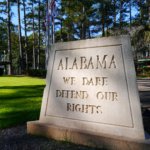 Selma was alive with events and speakers tucked into all corners of the town when we arrived on March 8, 2015—the 50th Anniversary of Bloody Sunday. According to multiple sources, an estimated 80,000 people crossed the Pettus Bridge that day with roughly 100,000 in attendance. Original foot soldiers who risked their lives crossing 50 years ago in the name of civil rights shared their story from church podiums and street corners—living relics bridging the gap between past and present histories. The Selma streets were flooded with tears, streaming with freedom songs and chants for justice. Strangers were greeting and hugging strangers. All against a devastating backdrop of strikingly pervasive poverty.
Selma was alive with events and speakers tucked into all corners of the town when we arrived on March 8, 2015—the 50th Anniversary of Bloody Sunday. According to multiple sources, an estimated 80,000 people crossed the Pettus Bridge that day with roughly 100,000 in attendance. Original foot soldiers who risked their lives crossing 50 years ago in the name of civil rights shared their story from church podiums and street corners—living relics bridging the gap between past and present histories. The Selma streets were flooded with tears, streaming with freedom songs and chants for justice. Strangers were greeting and hugging strangers. All against a devastating backdrop of strikingly pervasive poverty.
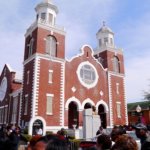 As we walked the streets, a block before Bethel Church on the left was a housing project. Mitchell and I had stopped to read a civil rights historical marker and ran into a woman who pointed to the marker photo recognizing one of the faces in the crowd as her neighbor. She then turned to the housing projects and pointed to her childhood home. This woman showed us which bedroom window used to be hers, and shared that Viola Liuzza had slept in her room when she came to town to march 50 years before. (Tragically, while transporting marchers to the Montgomery airport, Viola was murdered by the KKK.) Like countless, nameless black faces before her, there were also many who died while taking part in our country’s non-violent civil rights movement—a resistance for respect and human dignity.
As we walked the streets, a block before Bethel Church on the left was a housing project. Mitchell and I had stopped to read a civil rights historical marker and ran into a woman who pointed to the marker photo recognizing one of the faces in the crowd as her neighbor. She then turned to the housing projects and pointed to her childhood home. This woman showed us which bedroom window used to be hers, and shared that Viola Liuzza had slept in her room when she came to town to march 50 years before. (Tragically, while transporting marchers to the Montgomery airport, Viola was murdered by the KKK.) Like countless, nameless black faces before her, there were also many who died while taking part in our country’s non-violent civil rights movement—a resistance for respect and human dignity.
We spoke for awhile with a local family who said race relations in Selma, unfortunat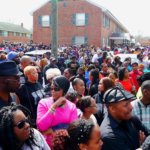 ely, “haven’t changed much at all.” That us white folk from out-of-town were different. The locals we befriended that afternoon were giving, salt-of-the-earth people not trying to make a buck off anybody—even when 100,000 people came to their town—which was consistent with all the local Selma residents we met. They shared with us their time, home, stories, and sweet gentleness. I am forever grateful.
ely, “haven’t changed much at all.” That us white folk from out-of-town were different. The locals we befriended that afternoon were giving, salt-of-the-earth people not trying to make a buck off anybody—even when 100,000 people came to their town—which was consistent with all the local Selma residents we met. They shared with us their time, home, stories, and sweet gentleness. I am forever grateful.
Over a month later, I find myself still processing the experience, and still processing my feelings. There was such a mix of emotions that ran the course of the day with me, and that still remain present. It took days and weeks after our return for me to fully remember what had happened that day; to identify my feelings of confusion, sadness, anger, gratitude, and loving unity; and to even make the connection with who Viola Liuzza was.
 I had the honor to experience Selma, and, fifty years later, She still has lessons to teach us. A town can be catalyst for change for an entire nation—not just policy but also a nationally-embraced change in perspective—yet dramatic shifts in healing race relations and poverty are still needed today. We have much work to do, especially on ourselves. For me, the deciding factor of putting in the work is the choice to no longer perpetuate the same cycles of dysfunction.
I had the honor to experience Selma, and, fifty years later, She still has lessons to teach us. A town can be catalyst for change for an entire nation—not just policy but also a nationally-embraced change in perspective—yet dramatic shifts in healing race relations and poverty are still needed today. We have much work to do, especially on ourselves. For me, the deciding factor of putting in the work is the choice to no longer perpetuate the same cycles of dysfunction.
I think about how we treat each other in my home state of South Carolina. Most recently, a white police officer was charged with murder after shooting an unarmed black man 8 times in the back. The sa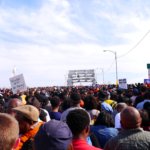 me week a USC student was suspended for writing the N word on a whiteboard as a reason for why the school’s wifi doesn’t work well. Criminalizing African American men has been institutionalized to the extent that they now make up eighty percent of our state’s prison population. South Carolina is second in the nation, last year we were first, in women murdered by men. And there’s currently no laws that address hate crimes nor discrimination based on sexual orientation.
me week a USC student was suspended for writing the N word on a whiteboard as a reason for why the school’s wifi doesn’t work well. Criminalizing African American men has been institutionalized to the extent that they now make up eighty percent of our state’s prison population. South Carolina is second in the nation, last year we were first, in women murdered by men. And there’s currently no laws that address hate crimes nor discrimination based on sexual orientation.
I assume we’ve all had moments of being disrespected based on who we are. I believe these moments are opportunities, if we so choose, that can provide the compassion to actively LISTEN to stories told by others—particularly people of color—about how they 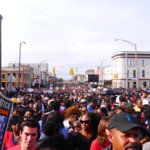 are confronted with such disrespect, marginalization, and systemic racism everyday. It’s not about recognizing others as victims, but rather gaining understanding and respect for what it takes to be a survivor and thriver in the face of various forms of oppression.
are confronted with such disrespect, marginalization, and systemic racism everyday. It’s not about recognizing others as victims, but rather gaining understanding and respect for what it takes to be a survivor and thriver in the face of various forms of oppression.
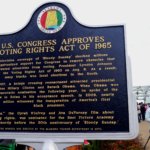 Despite the time that has passed, Selma stays with me. She keeps me company. She teaches me about the utter tragedies of poverty, and how it doesn’t defile the beauty of the individual, or the town. She recounts a national movement that grew with her, and the world watched as she exposed an ugly face of white supremacy and catalyzed the passing of civilized legislation (the Voting Rights Act of 1965). She reminds me, despite the successes, racism has yet to die. Regardless, She welcomes us back. She gives us a chance to learn, once again, and to experience the beauty of humanity in the midst of oppressive conditions. She loves unconditionally while bearing witness to, and exposing, injustice.
Despite the time that has passed, Selma stays with me. She keeps me company. She teaches me about the utter tragedies of poverty, and how it doesn’t defile the beauty of the individual, or the town. She recounts a national movement that grew with her, and the world watched as she exposed an ugly face of white supremacy and catalyzed the passing of civilized legislation (the Voting Rights Act of 1965). She reminds me, despite the successes, racism has yet to die. Regardless, She welcomes us back. She gives us a chance to learn, once again, and to experience the beauty of humanity in the midst of oppressive conditions. She loves unconditionally while bearing witness to, and exposing, injustice.
And so we ask—who will stand with Her?

